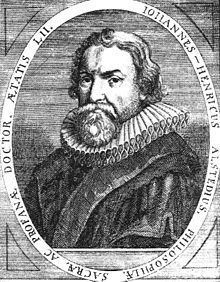Name Johann Alsted | ||
 | ||
Books Templum Musicum: Or The Musical Synopsis, Encyclopaedia | ||
Johann Heinrich Alsted (March 1588 – November 9, 1638) was a German Calvinist minister and academic, known for his varied interests: in Ramism and Lullism, pedagogy and encyclopedias, theology and millenarianism.
Contents
Life
Alsted was born in Mittenaar. He was educated at Herborn Academy in the state of Hesse, studying under Johannes Piscator. From 1606 he was at the University of Marburg, taught by Rudolf Goclenius, Gregorius Schonfeld and Raphael Egli. The following year he went to Basel, where his teachers were Leonhardt Zubler for mathematics, Amandus Polanus von Polansdorf for theology, and Johann Buxtorf. From about 1608 he returned to the Herborn Academy to teach as professor of philosophy and theology.
Alsted was later in exile from the Thirty Years' War in Transylvania, where he remained for the rest of his life. In 1629 he left war-torn Germany for Weisenburg (now Alba Iulia in Romania). He was to found a Calvinist Academy: the context was that the Transylvanian royal family had just returned from Unitarianism to Calvinism. Alsted and Johannes Bisterfeld were German professors brought in improve standards. Among the students there was Janos Apaczai Csere. Alsted died in Alba Iulia.
Logician
Alsted published Logicae Systema Harmonicum (1614). In writing a semi-Ramist encyclopedia, he then applied his conception of logic to the sum of human knowledge. To do that, he added the Lullist topical art of memory to Ramist topical logic, indeed reversing one of the original conceptions of Ramus. He had a reputation in his own time as a distinctive methodologist. John Prideaux in 1639 asked:
Q. Is it true that the seven dialectical theories of method in use today, to wit, i) the Aristotelian, 2) the Lullian, 3) the Ramistic, 4) the Mixt, whether indeed in the manner of Keckermann or of Alsted, 5) the Forensic of Hotman, 6) the Jesuitic, and 7) the Socinian, differ mostly in respect to manner of treatment, not in respect to purpose?
To which the pupil's answer was to be "yes"; as it was to be to the question "Is it true that a Mixt ought to be preferred to a Peripatetic, a Ramist, a Lullian, and the others?" A "Mixt" took elements from both Aristotle and Ramus; Philippo-Ramists, who blended Melanchthon with Ramus, were a type of "Mixt"; "Systematics" were "Mixts" who followed Keckermann in a belief in system, as Alsted did.
Encyclopedist
Alsted has been called 'one of the most important encyclopedists of all time'. He was a prolific writer, and his Encyclopaedia (1630) long had a high reputation. It was noticed that sedulitas, meaning "hard work" in Latin, was an anagram of Alstedius. It was preceded by shorter works, including the 1608 Encyclopaedia cursus philosophici. His major encyclopedia of 1630, the Encyclopaedia, Septem Tomis Distincta, was divided into 35 books, and had 48 synoptical tables as well as an index. In its time it was praised by Bernard Lamy, and criticised for plagiarism for verbatim copying without acknowledgment by Jacob Thomasius. Augustus De Morgan later called it "the true parent of all the Encyclopaedias, or collections of treatises, or works in which that character predominates".
The Cambridge History of Renaissance Philosophy, p. 632, in the context of Calvinist metaphysics, states
"In the works of authors like Clemens Timpler of Heidelberg and Steinfurt, Bartolomaeus Keckermann of Heidelberg and Danzig, and Johann Heinrich Alsted of Herborn there appeared a new, unified vision of the encyclopaedia of the scientific disciplines in which ontology had the role of assigning to each of the particular sciences its proper domain."
In his The New England Mind, Perry Miller writes about the Encyclopaedia:
"It was indeed nothing short of a summary, in sequential and numbered paragraphs, of everything that the mind of European man had yet conceived or discovered. The works of over five hundred authors, from Aristotle to James I, were digested and methodized, including those of Aquinas, Scotus, and medieval theology, as also those of medieval science, such as De Natura Rerum."It was reissued as a 4-volume facsimile reprint, edited by W. Schmidt-Biggemann (Fromann-Holzboog Press, Stuttgart-Bad Cannstatt, 1989–1990).
Theologian
From his Transylvanian period dates Alsted's Prodromus (printed 1641, but dated 1635). The Prodromus was a Calvinist refutation of one of the most influential anti-Trinitarian works, De vera religione of Johannes Volkel. This work was a compendium of the arguments of Volkel's teacher Fausto Sozzini, figurehead of the Polish Unitarian movement.
Works
Alsted is now remembered as an encyclopedist, and for his millennarian views. His approach to the encyclopedia took two decades of preliminaries, and was an effort of integration of tools and theories to hand.
In 1609 Alsted published Clavis artis Lullianae. He published the Artificium perorandi of Giordano Bruno in 1610; and in the same year the Panacea philosophica, an attempt to find the common ground in the work of Aristotle, Raymond Lull, and Petrus Ramus. In 1612 Alsted edited the Explanatio of Bernard de Lavinheta, a Lullist work. In 1613 he published an edition of the Systema systematum of Bartholomaus Keckermann. Theologia naturalis (1615) was an apologetical work of natural theology.
